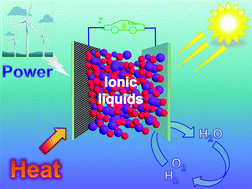Energy applications of ionic liquids
Abstract
Ionic liquids offer a unique suite of properties that make them important candidates for a number of energy related applications. Cation–anion combinations that exhibit low volatility coupled with high electrochemical and thermal stability, as well as ionic conductivity, create the possibility of designing ideal electrolytes for batteries, super-capacitors, actuators, dye sensitised solar cells and thermo-electrochemical cells. In the field of water splitting to produce hydrogen they have been used to synthesize some of the best performing water oxidation catalysts and some members of the protic ionic liquid family co-catalyse an unusual, very high energy efficiency water oxidation process. As fuel cell electrolytes, the high proton conductivity of some of the protic ionic liquid family offers the potential of fuel cells operating in the optimum temperature region above 100 °C. Beyond electrochemical applications, the low vapour pressure of these liquids, along with their ability to offer tuneable functionality, also makes them ideal as CO2 absorbents for post-combustion CO2 capture. Similarly, the tuneable phase properties of the many members of this large family of salts are also allowing the creation of phase-change thermal energy storage materials having melting points tuned to the application. This perspective article provides an overview of these developing energy related applications of ionic liquids and offers some thoughts on the emerging challenges and opportunities.


 Please wait while we load your content...
Please wait while we load your content...